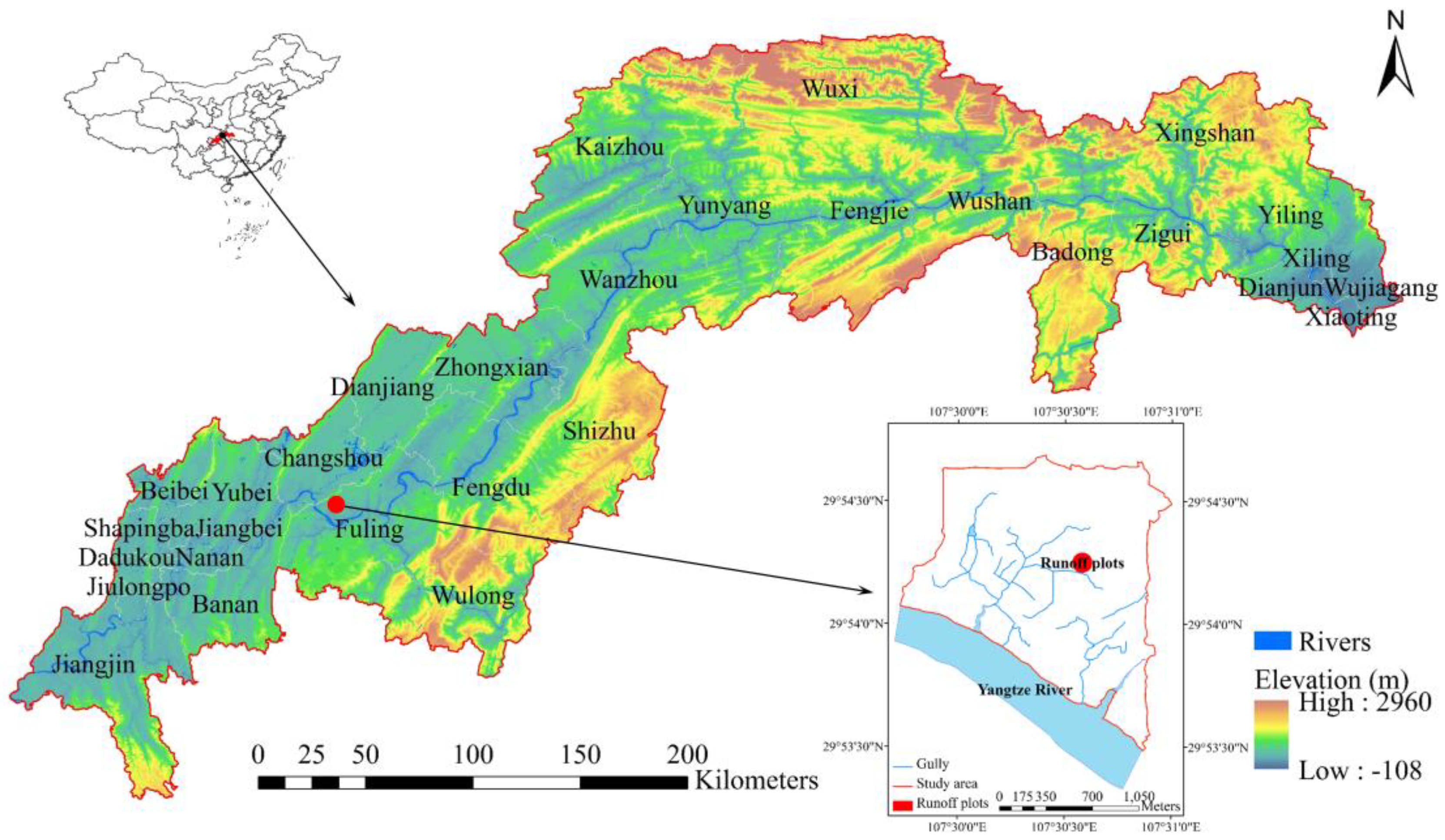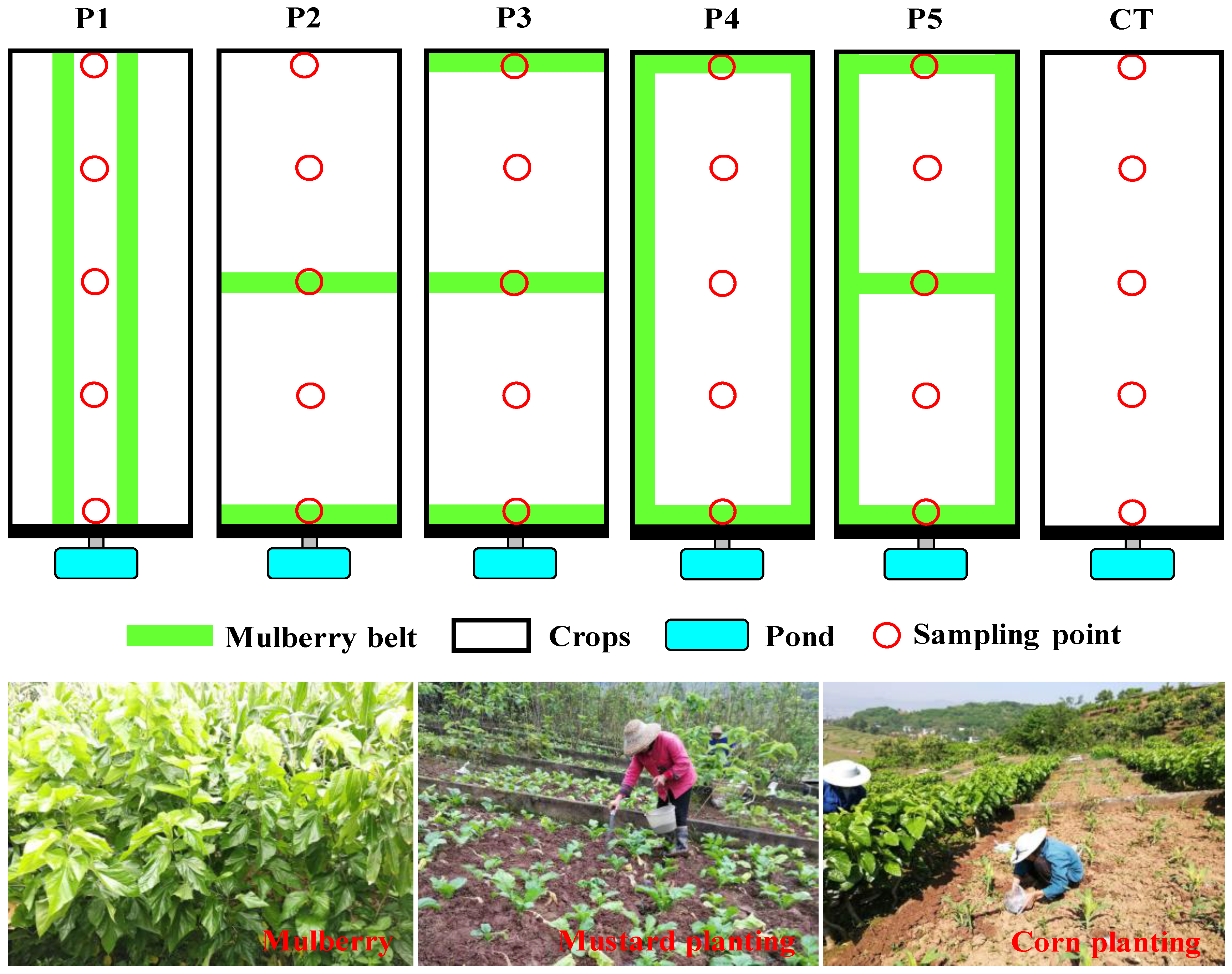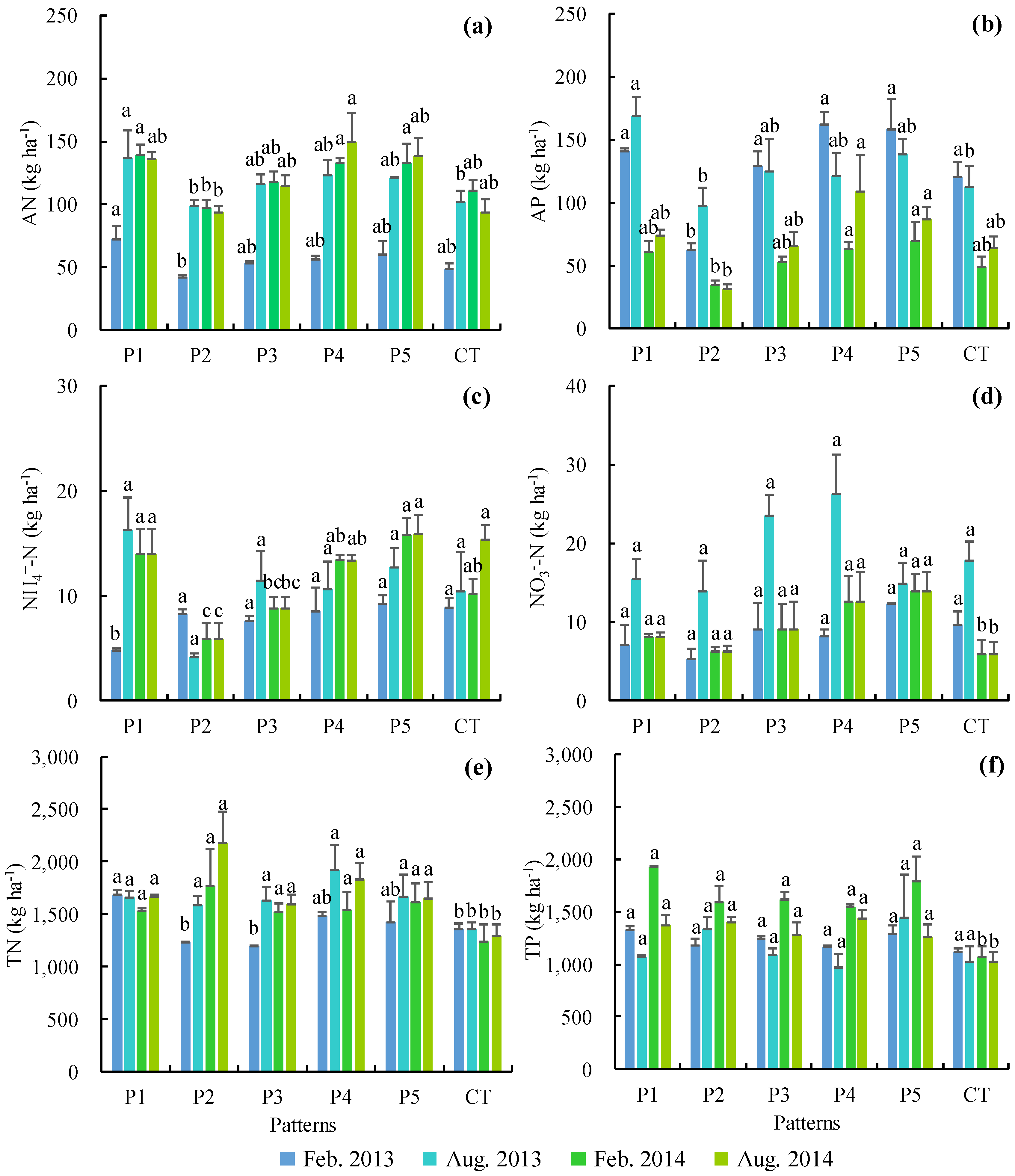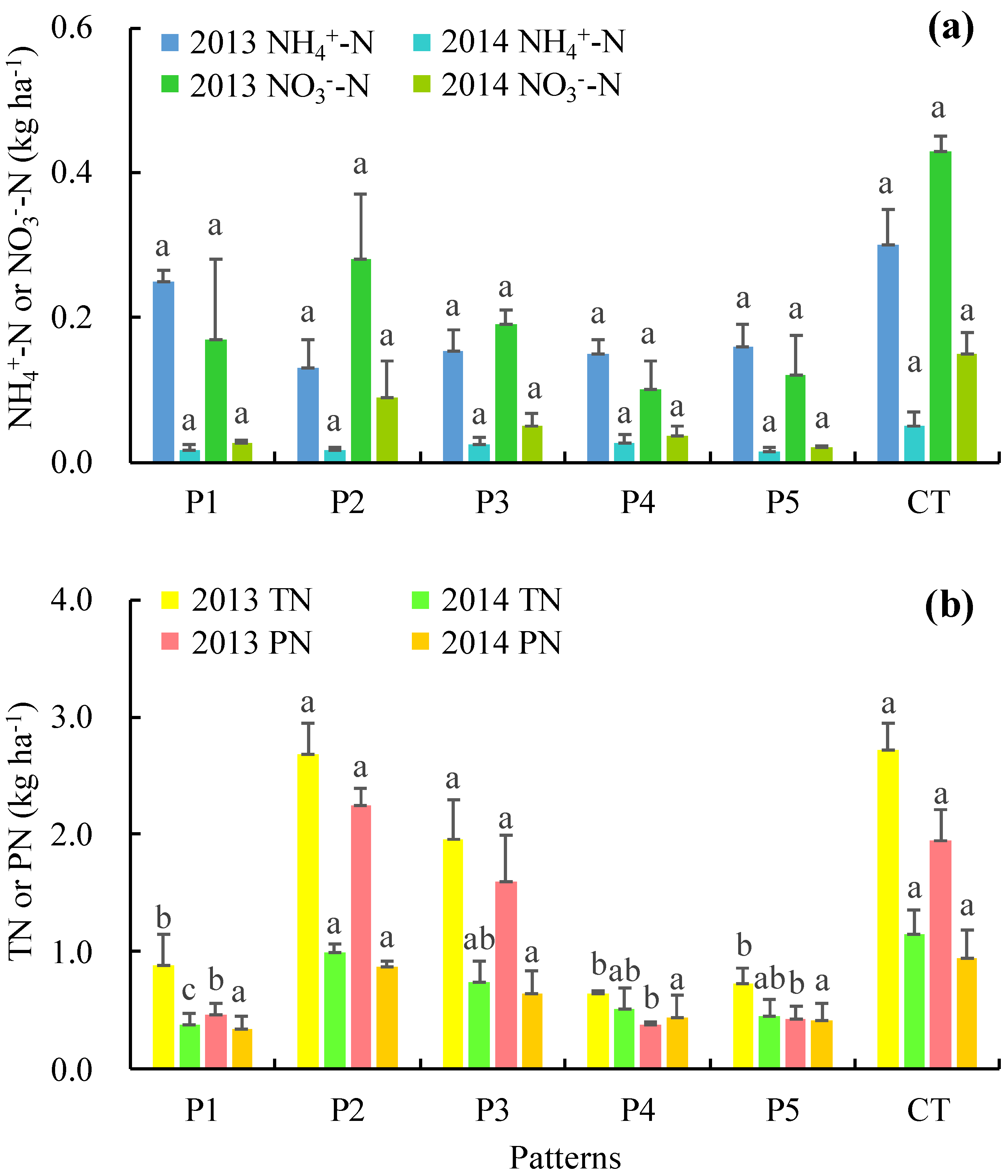Mechanized and Optimized Configuration Pattern of Crop-Mulberry Systems for Controlling Agricultural Non-Point Source Pollution on Sloping Farmland in the Three Gorges Reservoir Area, China
Abstract
1. Introduction
2. Materials and Methods
2.1. Study Area
2.2. Experimental Design
2.3. Sampling and Testing
2.4. Data Analysis
3. Results
3.1. Effects of Crop-Mulberry Systems on Soil Aggregate Structure
3.2. Effects of Crop-Mulberry Systems on Soil Nutrient Buildup
3.3. Effects of Crop-Mulberry Systems on Water and Soil Losses
3.4. Effects of Crop-Mulberry Systems on Runoff Nutrient Loss
4. Discussion
4.1. Crop-Mulberry Systems Effectively Improve Soil Internal Structure and Increase Soil Nutrient Buildup
4.2. Crop-Mulberry Systems Effectively Control the External Loss of Soil, Water, and Nutrients
5. Conclusions
Author Contributions
Funding
Conflicts of Interest
References
- Zhang, J.; Li, S.; Dong, R.; Jiang, C.; Ni, M. Influences of land use metrics at multi-spatial scales on seasonal water quality: A case study of river systems in the Three Gorges Reservoir Area, China. J. Clean Prod. 2019, 206, 76–85. [Google Scholar] [CrossRef]
- Geng, R.Z.; Sharpley, A.N. A novel spatial optimization model for achieve the trad-offs placement of best management practices for agricultural non-point source pollution control at multi-spatial scales. J. Clean Prod. 2019, 234, 1023–1032. [Google Scholar] [CrossRef]
- Brown, T.C.; Froemke, P. Nationwide Assessment of Nonpoint Source Threats to Water Quality. Bioscience 2012, 62, 136–146. [Google Scholar] [CrossRef]
- Carpenter, S.R.; Caraco, N.F.; Correll, D.L.; Howarth, R.W.; Sharpley, A.N.; Smith, V.H. Nonpoint pollution of surface waters with phosphorus and nitrogen. Ecol. Appl. 1998, 8, 559–568. [Google Scholar] [CrossRef]
- Chen, C.; Gao, M.; Xie, D.; Ni, J. Spatial and temporal variations in non-point source losses of nitrogen and phosphorus in a small agricultural catchment in the Three Gorges Region. Environ. Monit. Assess. 2016, 188, 257. [Google Scholar] [CrossRef]
- Moges, M.A.; Tilahun, S.A.; Ayana, E.K.; Moges, M.M.; Gabye, N.; Giri, S.; Steenhuis, T.S. Non-Point Source Pollution of Dissolved Phosphorus in the Ethiopian Highlands: The Awramba Watershed Near Lake Tana. Clean-Soil Air Water 2016, 44, 703–709. [Google Scholar] [CrossRef]
- Ongley, E.D.; Zhang, X.; Yu, T. Current status of agricultural and rural non-point source Pollution assessment in China. Environ. Pollut. 2010, 158, 1159–1168. [Google Scholar] [CrossRef] [PubMed]
- Wang, T.; Zhu, B.; Xia, L. Effects of Contour Hedgerow Intercropping on Nutrient Losses from the Sloping Farmland in the Three Gorges Area, China. J. Mt. Sci. 2012, 9, 105–114. [Google Scholar] [CrossRef]
- Zhang, Y.; Fan, F.; Zhou, C.; Ni, J.; Xie, D. Effects of Crop/Mulberry Intercropping on Surface Nitrogen and Phosphorus Losses in Three Gorges Reservoir Area. Acta Pedol. Sin. 2016, 53, 189–201. [Google Scholar]
- Zhang, P.; Yan, L.; Fan, J.; Jiang, P.; Wu, Y.; Cai, L.; Xu, H.; Wang, X.; Wu, S. Effects of Different Patterns of Contour Grass Hedgerow on Soil Erosion Control. J. Ecol. Rural Environ. 2011, 27, 29–34. [Google Scholar]
- Fan, F.; Xie, D.; Wei, C.; Ni, J.; Yang, J.; Tang, Z.; Zhou, C. Reducing soil erosion and nutrient loss on sloping land under crop-mulberry management system. Environ. Sci. Pollut. Res. 2015, 22, 14067–14077. [Google Scholar] [CrossRef] [PubMed]
- Pavlidis, G.; Tsihrintzis, V.A. Environmental Benefits and Control of Pollution to Surface Water and Groundwater by Agroforestry Systems: A Review. Water Resour. Manag. 2018, 32, 1–29. [Google Scholar] [CrossRef]
- Torralba, M.; Fagerholm, N.; Burgess, P.J.; Moreno, G.; Plieninger, T. Do European agroforestry systems enhance biodiversity and ecosystem services? A meta-analysis. Agric. Ecosyst. Environ. 2016, 230, 150–161. [Google Scholar] [CrossRef]
- Marais, Z.E.; Baker, T.P.; O’Grady, A.P.; England, J.R.; Tinch, D.; Hunt, M.A. A Natural Capital Approach to Agroforestry Decision-Making at the Farm Scale. Forests 2019, 10, 980. [Google Scholar] [CrossRef]
- Lovell, S.T.; Dupraz, C.; Gold, M.; Jose, S.; Revord, R.; Stanek, E.; Wolz, K.J. Temperate agroforestry research: Considering multifunctional woody polycultures and the design of long-term field trials. Agrofor. Syst. 2018, 92, 1397–1415. [Google Scholar] [CrossRef]
- Shrestha, B.M.; Chang, S.X.; Bork, E.W.; Carlyle, C.N. Enrichment Planting and Soil Amendments Enhance Carbon Sequestration and Reduce Greenhouse Gas Emissions in Agroforestry Systems: A Review. Forests 2018, 9, 369. [Google Scholar] [CrossRef]
- IUSS Working Group WRB. World Reference Base for Soil Resources 2014, update 2015 International Soil Classification System for Naming Soils and Creating Legends for Soil Maps; World Soil Resources Reports No. 106; IUSS Working Group WRB: Rome, Italy, 2015. [Google Scholar]
- Nyssen, J.; Poesen, J.; Moeyersons, J.; Lavrysen, E.; Haile, M.; Deckers, J. Spatial distribution of rock fragments in cultivated soils in northern Ethiopia as affected by lateral and vertical displacement processes. Geomorphology 2002, 43, 1–16. [Google Scholar] [CrossRef]
- Lal, R.; Shukla, M.K. Principles of Soil Physics; Marcel Dekker, Inc.: New York, NY, USA, 2004. [Google Scholar]
- Dane, J.H.; Topp, G.C. Methods of Soil Analysis, Part 4. Physical Methods; Soil Science Society of America: Madison, WI, USA, 2002. [Google Scholar]
- Sparks, D.L.; Page, A.L.; Helmke, P.A.; Loeppert, R.H.; Soltanpour, P.N.; Tabatabai, M.A.; Johnston, C.T.; Sumner, M.E. Methods of Soil Analysis, Part 3: Chemical Methods; Soil Science Society of America, Inc.: Madison, WI, USA, 1996. [Google Scholar]
- Khan, S.; Mulvaney, R.L.; Hoeft, R. A simple soil test for detecting sites that are nonresponsive to nitrogen fertilization. Soil Sci. Soc. Am. J. 2001, 65, 1751–1760. [Google Scholar] [CrossRef]
- Black, C.A. Methods of Soil Analysis, Part 2: Chemical and Microbiological Properties; American Society of Agronomy, Inc.: Madison, WI, USA, 1965. [Google Scholar]
- Olsen, S.R.; Cole, C.V.; Watanabe, F.S.; Dean, L.A. Estimation of Available Phosphorus in Soils by Extraction with Sodium Bicarbonate. USDA Circular No. 939; US Department of Agriculture: Washington, DC, USA, 1954.
- Du, J. Pedogenetic Features of Soils in the Purple Hilly Area of the Sichuan Basin. Ph.D. Thesis, Southwest University, Chongqing, China, 2014. [Google Scholar]
- Amezketa, E. Soil aggregate stability: A review. J. Sustain. Agric. 1999, 14, 83–151. [Google Scholar] [CrossRef]
- Lal, R. Soils and Sustainable Agriculture: A Review. In Sustainable Agriculture; Lichtfouse, E., Navarrete, M., Debaeke, P., Souchere, V., Alberola, C., Eds.; Springer: Berlin/Heidelberg, Germany, 2009. [Google Scholar]
- Hu, F.; Liu, J.; Xu, C.; Wang, Z.; Liu, G.; Li, H.; Zhao, S. Soil internal forces initiate aggregate breakdown and splash erosion. Geoderma 2018, 320, 43–51. [Google Scholar] [CrossRef]
- Bandyopadhyay, K.K.; Lal, R. Effect of land use management on greenhouse gas emissions from water stable aggregates. Geoderma 2014, 232, 363–372. [Google Scholar] [CrossRef]
- Yang, S.; Jansen, B.; Absalah, S.; van Hall, R.L.; Kalbitz, K.; Cammeraat, E.L.H. Lithology- and climate-controlled soil aggregate-size distribution and organic carbon stability in the Peruvian Andes. Soil 2020, 6, 1–15. [Google Scholar] [CrossRef]
- Cambardella, C.A.; Elliott, E.T. Particulate Soil Organic-Matter Changes across a Grassland Cultivation Sequence. Soil Sci. Soc. Am. J. 1992, 56, 777–783. [Google Scholar] [CrossRef]
- Gale, W.J.; Cambardella, C.A.; Bailey, T.B. Root-derived carbon and the formation and stabilization of aggregates. Soil Sci. Soc. Am. J. 2000, 64, 201–207. [Google Scholar] [CrossRef]
- Tisdall, J.M.; Oades, J.M. Organic matter and water-stable aggregates in soils. J. Soil Sci. 1982, 33, 141–163. [Google Scholar] [CrossRef]
- Yuan, J.; Peng, S.; Jiang, X.; Xie, D. Effects of combing ridge and no-tillage on aggregates and organic matter in a rice-based cropping system. Trans. CSAE 2010, 26, 153–160. [Google Scholar]
- Hu, F.; Xu, C.; Li, H.; Li, S.; Yu, Z.; Li, Y.; He, X. Particles interaction forces and their effects on soil aggregates breakdown. Soil Tillage Res. 2015, 147, 1–9. [Google Scholar] [CrossRef]
- Zhu, B.; Wang, Z.; Wang, T.; Dong, Z. Non-Point-Source Nitrogen and Phosphorus Loadings from a Small Watershed in the Three Gorges Reservoir Area. J. Mt. Sci. 2012, 9, 10–15. [Google Scholar] [CrossRef]
- Zhang, Q.; Chen, S.; Dong, Y.; Liu, D.; Yang, X.; Yang, Z. Controllability of phosphorus losses in surface runoff from sloping farmland treated by agricultural practices. Land Degrad. Dev. 2017, 28, 1704–1716. [Google Scholar] [CrossRef]
- Pu, Y.; Xie, D.; Ni, J.; Wei, C. Evaluation on comprehensive ecological benefits of different hedgerow patterns on slope-farmland in purple soil area. Chin. J. Eco-Agric. 2014, 22, 44–51. [Google Scholar]
- Adhikary, P.P.; Hombegowda, H.C.; Barman, D.; Jakhar, P.; Madhu, M. Soil erosion control and carbon sequestration in shifting cultivated degraded highlands of eastern India: Performance of two contour hedgerow systems. Agrofor. Syst. 2017, 91, 757–771. [Google Scholar] [CrossRef]
- Dercon, G.; Deckers, J.; Poesen, J.; Govers, G.; Sanchez, H.; Ramirez, M.; Vanegas, R.; Tacuri, E.; Loaiza, G. Spatial variability in crop response under contour hedgerow systems in the Andes region of Ecuador. Soil Tillage Res. 2006, 86, 15–26. [Google Scholar] [CrossRef]
- Sun, H.; Tang, Y.; Xie, J. Contour hedgerow intercropping in the mountains of China: A review. Agrofor. Syst. 2008, 73, 65–76. [Google Scholar] [CrossRef]
- Xia, L.; Hoermann, G.; Ma, L.; Yang, L. Reducing nitrogen and phosphorus losses from arable slope land with contour hedgerows and perennial alfalfa mulching in Three Gorges Area, China. Catena 2013, 110, 86–94. [Google Scholar] [CrossRef]







| Variable | Equation | R² |
|---|---|---|
| Sediment | y1 = 0.0012r − 0.0869 | 0.7957 |
| NH4+–N | y2 = 0.0001r + 0.0783 | 0.1735 |
| NO3−–N | y3 = 0.0007r − 0.0116 | 0.9232 |
| TN | y4 = 0.0051r + 0.0124 | 0.9651 |
| PN | y5 = 0.0042r − 0.0592 | 0.9062 |
| TP | y6 = 0.0007r + 0.0578 | 0.6031 |
| TDP | y7 = 0.0002r + 0.028 | 0.7045 |
© 2020 by the authors. Licensee MDPI, Basel, Switzerland. This article is an open access article distributed under the terms and conditions of the Creative Commons Attribution (CC BY) license (http://creativecommons.org/licenses/by/4.0/).
Share and Cite
Zhong, S.; Han, Z.; Li, J.; Xie, D.; Yang, Q.; Ni, J. Mechanized and Optimized Configuration Pattern of Crop-Mulberry Systems for Controlling Agricultural Non-Point Source Pollution on Sloping Farmland in the Three Gorges Reservoir Area, China. Int. J. Environ. Res. Public Health 2020, 17, 3599. https://doi.org/10.3390/ijerph17103599
Zhong S, Han Z, Li J, Xie D, Yang Q, Ni J. Mechanized and Optimized Configuration Pattern of Crop-Mulberry Systems for Controlling Agricultural Non-Point Source Pollution on Sloping Farmland in the Three Gorges Reservoir Area, China. International Journal of Environmental Research and Public Health. 2020; 17(10):3599. https://doi.org/10.3390/ijerph17103599
Chicago/Turabian StyleZhong, Shouqin, Zhen Han, Jiangwen Li, Deti Xie, Qingyuan Yang, and Jiupai Ni. 2020. "Mechanized and Optimized Configuration Pattern of Crop-Mulberry Systems for Controlling Agricultural Non-Point Source Pollution on Sloping Farmland in the Three Gorges Reservoir Area, China" International Journal of Environmental Research and Public Health 17, no. 10: 3599. https://doi.org/10.3390/ijerph17103599
APA StyleZhong, S., Han, Z., Li, J., Xie, D., Yang, Q., & Ni, J. (2020). Mechanized and Optimized Configuration Pattern of Crop-Mulberry Systems for Controlling Agricultural Non-Point Source Pollution on Sloping Farmland in the Three Gorges Reservoir Area, China. International Journal of Environmental Research and Public Health, 17(10), 3599. https://doi.org/10.3390/ijerph17103599






